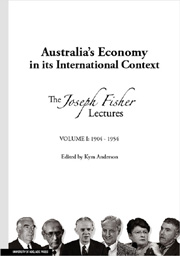Book contents
- Frontmatter
- Contents
- Preface
- List of lectures in volume 2 (1956-2009)
- Contributors to opening chapters
- The benefactor Joseph Fisher
- The lectures
- The lecturers
- 1 1904 – Commercial education
- 2 1906 – Commercial character
- 3 1908 – The influence of commerce on civilization
- 4 1910 – Banking as a factor in the development of trade and commerce
- 5 1912 – Australian company law, and some sidelights on modern commerce
- 6 1914 – Problems of transportation, and their relation to Australian trade and commerce
- 7 1917 – War finance: Loans, paper money and taxation
- 8 1919 – The humanizing of commerce and industry
- 9 1921 – Currency and prices in Australia
- 10 1923 – Money, credit and exchange
- 11 1925 – The Guilds
- 12 1927 – The financial and economic position of Australia
- 13 1929 – Public finance in relation to commerce
- 14 1930 – Current problems in international finance
- 15 1932 – Australia's share in international recovery
- 16 1934 – Gold standard or goods standard
- 17 1936 – Some economic effects of the Australian tariff
- 18 1938 – Australian economic progress against a world background
- 19 1940 – Economic coordination
- 20 1942 – The Australian economy during War
- 21 1942 – Problems of a high employment economy
- 22 1946 – Necessary principles for satisfactory agricultural development in Australia
- 23 1948 – The importance of the iron and steel industry
- 24 1950 – The economic consequences of scientific research
- 25 1952 – Australian agricultural policy
- 26 1954 – The economics of Federal-State finance
23 - 1948 – The importance of the iron and steel industry
Published online by Cambridge University Press: 05 June 2012
- Frontmatter
- Contents
- Preface
- List of lectures in volume 2 (1956-2009)
- Contributors to opening chapters
- The benefactor Joseph Fisher
- The lectures
- The lecturers
- 1 1904 – Commercial education
- 2 1906 – Commercial character
- 3 1908 – The influence of commerce on civilization
- 4 1910 – Banking as a factor in the development of trade and commerce
- 5 1912 – Australian company law, and some sidelights on modern commerce
- 6 1914 – Problems of transportation, and their relation to Australian trade and commerce
- 7 1917 – War finance: Loans, paper money and taxation
- 8 1919 – The humanizing of commerce and industry
- 9 1921 – Currency and prices in Australia
- 10 1923 – Money, credit and exchange
- 11 1925 – The Guilds
- 12 1927 – The financial and economic position of Australia
- 13 1929 – Public finance in relation to commerce
- 14 1930 – Current problems in international finance
- 15 1932 – Australia's share in international recovery
- 16 1934 – Gold standard or goods standard
- 17 1936 – Some economic effects of the Australian tariff
- 18 1938 – Australian economic progress against a world background
- 19 1940 – Economic coordination
- 20 1942 – The Australian economy during War
- 21 1942 – Problems of a high employment economy
- 22 1946 – Necessary principles for satisfactory agricultural development in Australia
- 23 1948 – The importance of the iron and steel industry
- 24 1950 – The economic consequences of scientific research
- 25 1952 – Australian agricultural policy
- 26 1954 – The economics of Federal-State finance
Summary
Introduction
It is a great honour to be invited by the Council of the University of Adelaide to deliver the 1948 Joseph Fisher Lecture on “The Importance of the Steel Industry to Australia.” It is a subject which is all-absorbing and is especially interesting to South Australia, the State which supplies the Australian steel industry and allied works with two of their major raw materials, iron ore and limestone, and some of their lesser known requirements, dolomite, salt and gypsum. Mr. I. McLennan has largely assisted in the collecting of data and facts for this lecture.
Early history
The early history of the industry is interesting. Iron Smelting was first established in 1848, just one hundred years ago, in the vicinity of Mittagong (then called Nattai) in New South Wales. This was a small enterprise and despite several attempts achieved little success. It was finally abandoned in 1886. In 1874, Mr. James Rutherford in association with other well known colonists set about establishing a blast furnace at Lithgow, New South Wales, and in 1875 the Eskbank Iron Works commenced operations. Mr. William Sandford was the lessee of the Mittagong Works in the 1880's and when in 1886 he abandoned them he took over the Works at Lithgow. Under his direction the plant was extended and on January 15, 1894, the first sheet rolling mill in this country was started. On the 24th April, 1900, an important milestone in the history of the industry was passed when the first heat of open hearth steel made in Australia was tapped from a newly erected 4-ton furnace at the Lithgow Works.
- Type
- Chapter
- Information
- Australia's Economy in its International ContextThe Joseph Fisher Lectures, pp. 589 - 620Publisher: The University of Adelaide PressPrint publication year: 2009



